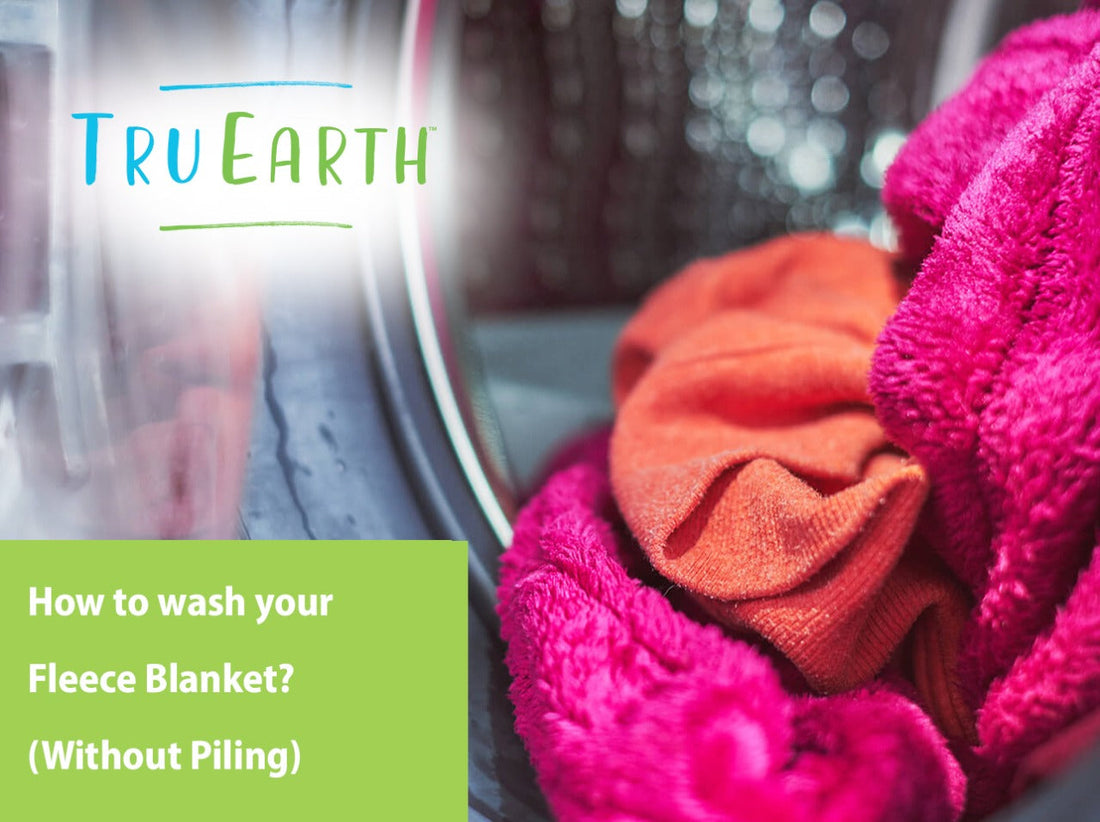We hebben allemaal wel dekens en plaids die hun beste tijd hebben gehad. En we hebben allemaal dekens waarvan de stof pillt en er minder pluizig uitziet dan vroeger. Gelukkig zijn wij er om je te vertellen: gooi je gezellige woonaccessoire nog niet weg!
Geloof het of niet, je kunt stappen ondernemen om iets van die oorspronkelijke zachtheid terug te krijgen - en die jarenlang te behouden. Deze blogpost laat je zien hoe je je fleece deken kunt wassen zonder te pillen of schade te veroorzaken. Klaar om je geliefde stoffen vriend een hart onder de riem te steken? Lees verder!

Een fleecedeken wassen
Fleece dekens zijn een geweldige manier om warm en comfortabel te blijven, maar het is belangrijk om te weten hoe je ze moet wassen om hun zachtheid te behouden en pilling te voorkomen. De sleutel tot succesvol reinigen ligt in het begrijpen van de beste technieken en het zorgvuldig volgen ervan.
Behandel vlekken
Om een vlek op een fleece deken effectief te verwijderen, is het het beste om de vlek te behandelen voordat u hem in de wasmachine doet. Sommige dekens kunnen vetvlekken of voedselvlekken bevatten die verwijderd moeten worden. Deze vlekken moeten eerst worden verwijderd voordat u de deken volledig wast.
Bij het reinigen van een fleecedeken is het belangrijk om de instructies van de fabrikant te volgen. Deze instructies staan vaak op een lipje dat aan de deken zelf is bevestigd, of in een bijsluiter die bij het product wordt geleverd, en worden geleverd in de vorm van wassymbolen of gebruiksaanwijzingen.
Nadat u het waslabel hebt gelezen, moet u ervoor zorgen dat u een mild wasmiddel gebruikt dat speciaal is ontwikkeld voor het wassen van wollen stoffen. Een kleine hoeveelheid zeep op de vlek kan helpen om de vlek te verwijderen.
Laat de zeep ongeveer tien minuten intrekken voordat u een handdoek neemt en de overtollige zeep voorzichtig opdept. Wrijven of schrobben kan ertoe leiden dat de vlek dieper in de vezels wordt geduwd, waardoor deze moeilijker te verwijderen is.

Als één poging niet voldoende is, probeer het dan opnieuw met meer zeep totdat het gewenste resultaat is bereikt. Als bepaalde soorten vlekken, zoals verf- of wijnvlekken , hardnekkig blijven zitten, kunnen andere oplossingen zoals oxy-clean nodig zijn om ze volledig te verwijderen. Het is belangrijk om te weten dat bleekmiddel de vezels van de stof kan beschadigen, wat kan leiden tot pilling of scheuren. Gebruik het daarom liever niet.
Een fleecedeken wassen
Om je deken te wassen, begin je met het wassen van één fleecedeken in de wasmachine, zonder andere items. Het is meestal beter om geen verschillende stoffen te mengen tijdens het wassen om onnodige slijtage of schade door wrijving tegen andere items in de machine te voorkomen.
Stel de wasmachine vervolgens in op "fijnwas" en voeg slechts een kleine hoeveelheid wasmiddel toe. Het wasmiddel dat u gebruikt, is erg belangrijk voor het resultaat van uw fleecedeken. Een betrouwbare, milieuvriendelijke oplossing zijn de wasmiddelstrips van Tru Earths .
Deze strips zijn gemaakt van de beste ingrediënten en bevatten geen 1,4-dioxaan, parabenen, fosfaten, toegevoegde kleurstoffen en chloorbleekmiddel. Met andere woorden: uw kleding wordt schoon zonder resten achter te laten, zoals traditionele wasmiddelen dat doen, maar dan beter. Wij maken het gewoon gezonder voor u en het milieu.

Deze wasstrips bevatten alle reinigingskracht van een gewoon wasmiddel in een kleine, voorgedoseerde strip die je zo in de wasmachine gooit. Ze zijn milieuvriendelijk, hypoallergeen en ultrageconcentreerd, wat betekent dat één strip voldoende is om een hele was te wassen. Daarom zijn deze strips de perfecte keuze voor het wassen van je fleecedekens.
Het is belangrijk om te benadrukken dat wasverzachters niet gebruikt mogen worden, omdat ze de vezels van de stof kunnen beschadigen en verzwakken. Bovendien kan het gebruik van heet water leiden tot overmatige krimp, waardoor de deken onbruikbaar of ondraagbaar wordt.
Het drogen van uw fleecedeken
Een fleecedeken aan de lucht drogen is over het algemeen de veiligste methode om pilling te voorkomen. Waslijnen werken het beste bij warmer weer, maar als de temperatuur daalt, is een droger op een milde stand mogelijk de enige optie.
Houd er rekening mee dat hoogwaardige materialen beter bestand zijn tegen hitte dan materialen van lagere kwaliteit. De kans op succes is dus groter als uw deken niet is gemaakt van synthetische vezels, maar van natuurlijke wol of katoen.
Als drogen aan de lucht niet mogelijk is, wees dan voorzichtig bij het gebruik van de droger door het programma voor een zachter programma te kiezen en de deken er direct na gebruik uit te halen. Controleer de deken op tekenen van pilling voordat u hem opvouwt en opbergt.
Afhankelijk van de grootte kan het nuttig zijn om je fleecedeken af en toe buiten uit te schudden om de vezels op te schudden en te voorkomen dat er pluisjes of vuil ophopen. Met de juiste verzorging en onderhoud kun je nog vele koude nachten genieten van je comfortabele fleecedeken!

Waarom ontstaat pilling?
Kortom, pilling op truien en dekens kan optreden als ze van slechte kwaliteit of erg oud zijn. Dit gebeurt omdat de draden niet strak genoeg geweven zijn, waardoor ze bij het wassen los kunnen raken. Investeer daarom het beste in een hoogwaardige fleecedeken die strak geweven en duurzamer is om pilling of beschadiging door het wassen te voorkomen.
Bovendien gaat dit type deken langer mee en is het de extra kosten waard. Bij het wassen van fleecedekens is het altijd belangrijk om de specifieke wasinstructies zorgvuldig te volgen voor het beste resultaat. Het is ook belangrijk om te onthouden dat verschillende soorten stof verschillende wastechnieken vereisen.
Sommige materialen hebben bijvoorbeeld koud water nodig, terwijl andere juist warm water nodig hebben voor het beste resultaat. Bovendien zorgt het gebruik van een mild wasmiddel speciaal voor polyester ervoor dat je fleecedeken goed wordt onderhouden en veel langer meegaat.
Gratis verzending*


